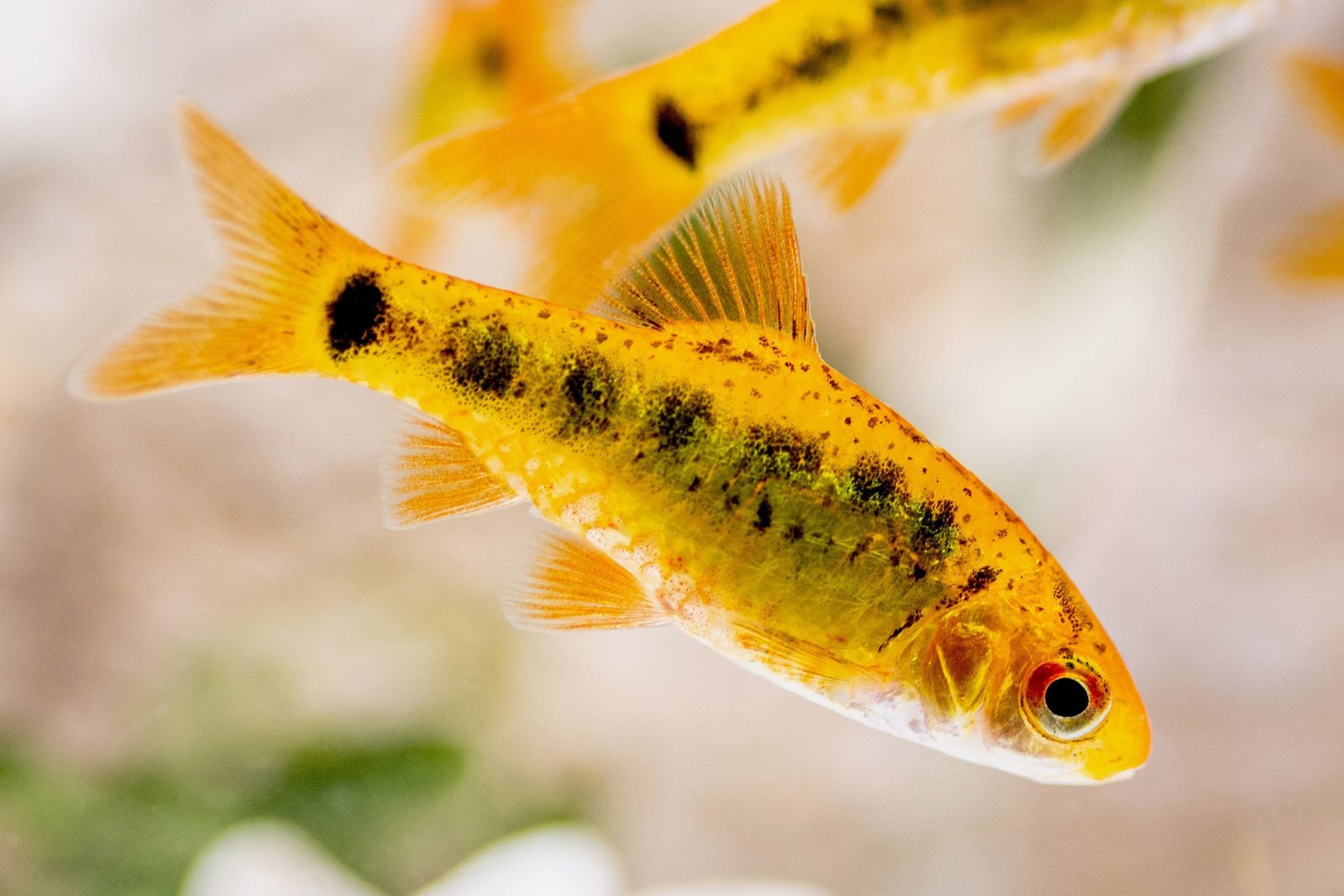Barbs are lively, hardy, and colorful fish in the minnow family Cyprinidae. They prefer soft acidic water that is well aerated and a bit on the cooler side.
It is recommended to keep them in groups of at least five or more for the best results. Different species of barbs such as tiger barbs, gold barbs, and rosy barbs have their own unique characteristics and care requirements. In this fish species profile, we will explore these different types of barbs, including their origin, habitat, appearance, lifespan, tank requirements, diet, and compatibility with other fish.
Whether you are a beginner or an experienced aquarium enthusiast, this guide will provide you with all the essential information you need to know about barb fish.
Introduction To Barb Fish
Barb fish, part of the minnow family Cyprinidae, are lively, hardy, and colorful species that thrive when kept in groups of five or more. Learn more about their origins, behavior, aquarium requirements, and tank mates in this comprehensive fish species profile.
Overview Of Barb Fish
Barb fish, also known as barbels, are a diverse group of freshwater fish that belong to the family Cyprinidae. They are known for their vibrant colors, lively behavior, and unique fin shapes. With over 350 different species, barbs come in a wide range of sizes, from small nano-barbs to larger species like the Giant Barb.Characteristics Of Barb Fish
Barb fish are characterized by their elongated bodies, laterally compressed shapes, and the presence of barbels around their mouths. These barbels, which give them their name, are sensory organs that help them locate food in dark or muddy waters. Barbs are renowned for their colorful appearance, with species exhibiting a dazzling array of patterns and shades. From the bright red and striking black stripes of the Tiger Barb to the golden hues of the Gold Barb, these fish are a sight to behold in any aquarium. Another notable characteristic of barb fish is their lively behavior. They are known for their playful and active nature, often darting around the tank and engaging in social interactions with other fish. This makes them a great choice for aquarium enthusiasts looking to add energy and vibrancy to their aquatic environment.Distribution And Habitat
Barb fish can be found in various regions around the world, primarily in Asia and Africa. They inhabit a wide range of aquatic environments, including rivers, streams, ponds, and even floodplains. Some species, like the Giant Barb, are endemic to specific regions and are considered critically endangered due to habitat loss and overfishing. In terms of habitat, barbs prefer slow-flowing waters with plenty of vegetation and hiding places. They are well-adapted to different water conditions and can thrive in both soft and hard water environments. However, it’s important to note that specific water parameters may vary depending on the species of barb fish being kept. Overall, barb fish are fascinating creatures that add beauty and activity to any freshwater aquarium. Their vibrant colors, lively behavior, and adaptability make them a popular choice among aquarium enthusiasts. Whether you’re a beginner or an experienced hobbyist, barb fish are sure to bring life and excitement to your aquatic setup.
Credit: m.youtube.com
Different Species Of Barb Fish
Barbs are lively, hardy, and colorful fish in the minnow family Cyprinidae. There are various species of barb fish, including the banded barb, denison barb, rosy barb, odessa barb, cherry barb, tiger barb, gold barb, golden barb, five banded, panda barb, and ruby barb.
These fish thrive when kept in groups of at least five or more.
Tiger Barb
Tiger Barb (Puntigrus tetrazona) is a popular fish species among aquarium enthusiasts due to its vibrant colors and playful nature. These barbs are native to Southeast Asia, specifically Sumatra, Borneo, and Peninsular Malaysia.
Characterized by their black vertical stripes that resemble a tiger’s pattern, Tiger Barbs can add a splash of color and movement to any freshwater aquarium. They typically grow up to 3 inches in size and have a lifespan of 5 to 7 years in captivity.
When it comes to tank setup, Tiger Barbs thrive in densely planted aquariums with plenty of swimming space. They are shoaling fish, which means they prefer to be kept in groups of at least 5 individuals to mimic their natural behavior. A spacious tank with a minimum capacity of 20 gallons is recommended to accommodate their active nature.
Tiger Barbs are omnivores, and their diet consists of both plant matter and small invertebrates. They readily accept commercially available flake foods, pellets, and live or frozen foods such as brine shrimp and bloodworms.
Golden Barb
Golden Barb (Puntius gelius) is another mesmerizing species of barb fish that aquarium enthusiasts adore. These barbs are native to Southeast Asia, particularly in rivers and streams of Bangladesh, India, and Myanmar.
Featuring a striking golden-yellow coloration, the Golden Barb is known for its peaceful nature, making it an ideal addition to community aquariums. They are generally small, growing up to 2 inches in size, and have a lifespan of 3 to 5 years in captivity.
In terms of tank requirements, Golden Barbs prefer densely planted aquariums with plenty of hiding spots and open swimming areas. A tank size of at least 10 gallons is recommended for a small group of Golden Barbs to thrive.
Golden Barbs are omnivorous and will readily accept a varied diet. They enjoy a mix of high-quality flake foods, small pellets, and live or frozen foods such as daphnia and mosquito larvae. Feeding them a balanced diet will enhance their coloration and overall health.
Rosy Barb
Rosy Barb (Pethia conchonius) is a charming species of barb fish known for its vibrant metallic pink or red coloration. These barbs originate from rivers and lakes of southern Asia, specifically India, Pakistan, and Nepal.
With their eye-catching colors and peaceful temperament, Rosy Barbs make wonderful additions to community aquariums. They grow up to 4 inches in size and have a lifespan of 4 to 6 years in captivity.
Rosy Barbs prefer well-planted aquariums with a spacious swimming area. A tank size of 20 gallons or more is recommended to house a small group of Rosy Barbs comfortably. They are known to be active swimmers, so providing ample swimming space is essential for their well-being.
These barbs are omnivorous, and their diet should consist of a mix of high-quality flake foods, small pellets, and live or frozen foods like daphnia and brine shrimp. Supplementing their diet with vegetables such as blanched spinach or lettuce can also provide them with additional nutrition.
Caring For Barb Fish
Barb fish, belonging to the minnow family Cyprinidae, are lively, hardy, and colorful. They thrive in groups of at least five or more, making it important to consider tank size for proper care. Learn more about their origins, behavior, and tank requirements in this comprehensive fish species profile.
Aquarium Requirements
When it comes to caring for barb fish, providing them with the right aquarium setup is crucial. Barbs are active swimmers that thrive in spacious tanks, so it’s important to choose a tank that can accommodate their energetic nature. A tank size of at least 20 gallons is recommended for a small group of barbs, but larger tanks are preferred for bigger schools. Additionally, barbs prefer a well-filtered tank with a strong current. Adequate filtration keeps the water clean and maintains optimal water parameters.Feeding Habits
To maintain the health and vibrancy of your barb fish, a well-balanced diet is essential. Barbs are omnivorous, which means they eat both plant matter and small insects in the wild. In an aquarium setting, it’s important to replicate their natural diet by providing a variety of foods. High-quality flakes or pellets should be the staple of their diet, but it’s also beneficial to include frozen or live foods such as brine shrimp, bloodworms, and daphnia. Feeding small, frequent meals throughout the day mimics their natural feeding behavior.Tank Mates And Compatibility
When choosing tank mates for your barb fish, it’s important to consider their natural behavior and compatibility. Barbs are generally peaceful fish, but some species can be slightly aggressive, particularly during breeding or if they feel threatened. It’s best to avoid keeping barbs with long-finned fish like bettas or angelfish, as they may see their flowing fins as potential targets. Instead, opt for species that can withstand the occasional chase, such as danios, rasboras, or peaceful tetras. Providing plenty of hiding spots and plants in the tank can also help alleviate aggression.Breeding And Lifespan
Breeding barb fish can be a rewarding experience for aquarists. To encourage breeding, it’s important to create the right conditions in the aquarium. This includes providing ideal water parameters, such as slightly warmer temperatures and slightly acidic water. Barbs typically scatter their eggs among plants, so having plenty of vegetation in the tank is essential. Once the eggs are laid, the parents should be removed as they may eat their own eggs. The eggs usually hatch within a few days and the fry can be fed with infusoria or crushed flakes. In terms of lifespan, barb fish generally live for several years when provided with proper care. Depending on the species, their lifespan can range from 3 to 7 years. Providing a balanced diet, clean water, and suitable tank mates will help ensure the longevity of your barb fish. In conclusion, caring for barb fish involves providing them with the right aquarium requirements, feeding a well-balanced diet, selecting compatible tank mates, and understanding their breeding habits and lifespan. By providing optimal care, you can enjoy the beauty and vibrancy of these captivating fish in your own aquarium.
Credit: m.youtube.com
:strip_icc()/GettyImages-938498166-3379368141b9463c849f5b548ee41acb.jpg)
Credit: www.thesprucepets.com
Frequently Asked Questions Of Barb: Fish Species Profile
What Are The Characteristics Of A Barb Fish?
Barb fish are lively, hardy, and colorful. They are schooling fish that do best in groups of at least five. Most barbs prefer soft, acidic water and cooler temperatures. Some peaceful species like cherry barbs make great community tank inhabitants.
Tiger barbs can be aggressive and should not be kept with small or long-finned fish. Barbs live in lagoons and slow-flowing rivers, and the Giant Barb is the largest freshwater species in the world.
Are Barbs Good Community Fish?
Barbs are lively, colorful fish that do best in groups of at least five or more. Some species, like cherry and gold barbs, are peaceful and make great community tank inhabitants. However, be cautious with long-finned fish as they may get nibbled.
Do Barb Fish Eat Other Fish?
Barb fish may eat other fish, especially smaller ones and those with long fins. It’s best to keep them away from betta fish and angelfish to avoid any nibbling.
What Are Some Fun Facts About Barb Fish?
Barb fish are lively and colorful, belonging to the minnow family Cyprinidae. They prefer to live in groups of at least five or more and thrive in soft and slightly cooler water. The Giant Barb is the largest freshwater species in the world and they are found in lagoons and slow-flowing rivers in Europe, Asia, and Africa.
Conclusion
Barbs are lively, hardy, and colorful fish that thrive when kept in groups. They prefer soft acidic water and cooler temperatures. With their origins in Borneo and Malaysia, these fish are known for their vibrant patterns and active behavior. When choosing tank mates, be mindful of their compatibility.
Barbs make a great addition to any aquarium, bringing both beauty and liveliness to your underwater world.


